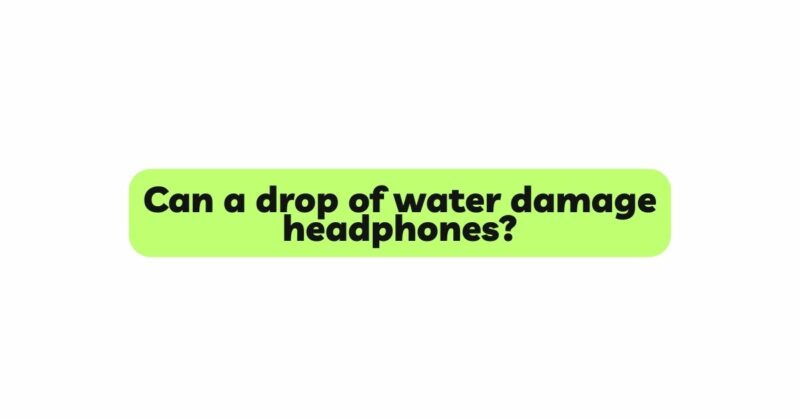Headphones have become an essential part of our daily lives, providing us with a private oasis of music, podcasts, and immersive audio experiences. In our fast-paced world, accidents can happen, and one of the most common fears is the possibility of water damage to our precious headphones. Whether it’s a sudden rain shower, accidental spill, or even perspiration during a workout, exposure to water can be a cause for concern. This raises the question: can a drop of water damage headphones? In this article, we will delve into the potential effects of water exposure on headphones, examining the structural vulnerabilities, the consequences on audio quality, and ways to prevent and mitigate water damage. By understanding the implications of water exposure, users can take measures to protect their headphones and ensure a prolonged and enjoyable audio journey.
- The Vulnerability of Headphones to Water
Modern headphones are not typically designed to be fully waterproof or water-resistant, making them vulnerable to water damage. Most headphones feature openings and vents that allow for air circulation and sound transmission, but these openings can also allow water to seep into sensitive internal components. Moreover, the materials used in headphones, such as foam, fabric, plastic, and metal, are susceptible to water absorption and corrosion.
In-ear headphones and earbuds are particularly vulnerable due to their proximity to the ear canal. The presence of tiny drivers and the potential for earwax accumulation make them even more susceptible to water damage. Over-ear and on-ear headphones have less exposure to the ear canal but can still be at risk when exposed to water.
- Immediate Effects of Water Exposure
When a drop of water comes into contact with headphones, the immediate effects can vary depending on factors such as the amount of water, the location of exposure, and the headphone’s build quality. Some immediate effects of water exposure include:
a. Muffled Sound: Water can obstruct sound transmission, leading to a muffled or distorted audio output.
b. Audio Imbalances: Uneven water exposure on the drivers or cables can cause imbalances in audio output between the left and right earpieces.
c. Inconsistent Performance: Water can interfere with electrical circuits and signal transmission, leading to inconsistent or erratic performance.
d. Signal Disruption: Water can create short circuits, causing the headphones to stop working altogether.
- Long-Term Consequences of Water Damage
Even if headphones appear to work fine after initial water exposure, there can be long-term consequences that manifest over time. These consequences may not be immediately noticeable but can become evident as the headphones continue to be used. Long-term effects of water damage can include:
a. Corrosion: Water can corrode metal components, leading to deterioration and reduced audio performance.
b. Mold and Mildew: Moisture can promote the growth of mold and mildew, which can impact the materials and contribute to foul odors.
c. Electrical Issues: Over time, water damage can cause electrical components to degrade, leading to audio malfunctions.
d. Decreased Lifespan: Water damage can accelerate the wear and tear of headphone components, leading to a reduced lifespan.
- Water Resistance and Waterproofing
Some headphone models come with water resistance or waterproofing features, which provide varying degrees of protection against water exposure. Water-resistant headphones are designed to withstand light splashes, sweat, and moisture, making them suitable for workouts or casual outdoor use. On the other hand, fully waterproof headphones are designed to endure submersion in water and are ideal for activities like swimming or water sports.
It is essential to understand the water resistance rating (IPX) of headphones, as not all water-resistant headphones are suitable for the same level of water exposure. Users should follow the manufacturer’s guidelines for water-resistant headphones and refrain from subjecting them to excessive water exposure beyond their specified capabilities.
- Preventive Measures to Protect Headphones from Water Damage
To safeguard headphones from water damage and extend their longevity, users can adopt several preventive measures:
a. Keep Headphones Dry: Avoid exposing headphones to water, especially during rain, water activities, or intense sweating.
b. Use Water-Resistant or Waterproof Headphones: Consider investing in headphones with appropriate water resistance ratings, especially for outdoor or workout activities.
c. Use Protective Covers: If using headphones during workouts or in humid conditions, consider using moisture-absorbing covers or silicone sleeves to protect them from perspiration.
d. Store Headphones Properly: When not in use, store headphones in a dry and secure location, away from potential sources of water exposure.
e. Perform Regular Maintenance: Regularly inspect and clean headphones, removing any moisture or debris that may have accumulated.
f. Respond Immediately to Water Exposure: If headphones come into contact with water, dry them thoroughly and avoid using them until they are completely dry.
g. Seek Professional Assistance: If headphones have been significantly exposed to water, seek professional assistance from the manufacturer or authorized service centers.
Conclusion
While accidental water exposure can pose a significant risk to headphone quality and performance, users can take proactive measures to protect their audio investment. Understanding the vulnerabilities of headphones to water exposure is crucial in preventing potential damages. Water exposure can have immediate effects, such as muffled sound, audio imbalances, and signal disruption, and can also lead to long-term consequences like corrosion, mold growth, and decreased lifespan.
By adopting preventive measures, using water-resistant or waterproof headphones where appropriate, and responding immediately to water exposure, users can ensure that their headphones continue to deliver a symphony of sound for many enjoyable audio experiences to come. Taking care of headphones will not only preserve audio excellence but also extend the life of these cherished audio companions.


